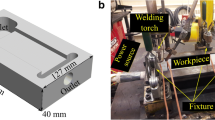Abstract
The efficiency as well as the knowledge of the energy flow of welding processes is a fundamental coefficient to realize high-quality joints. The increasing use of high-strength materials with a small processing range as well as the demand to simulate resulting component properties increase the demand of exact knowledge of the heat input. Experiments show that the heat input into the component is highly influenced by the selection of welding parameters. Measurements confirm that it is possible to increase the efficiency of welding processes for example by reducing the wire feed speed in gas metal arc welding (GMAW), using carbon dioxide shielding gas or increasing the stick-out length. On the contrary, increasing the current or voltage or reducing the shielding gas flow reduces the process efficiency. The difference between the lowest and highest achievable value of efficiency can be more than 15 % for one specific welding process. In this work, the efficiencies of different groups of welding processes are compared. Due to the use of unique measurement systems and systematical analyses of influencing parameters, a comprehensive overview for different welding processes is possible for the first time.










Similar content being viewed by others
References
Pepe N, Yapp D (2008) Measurements of process efficiency for a range of MIG/MAG welding process. In: 17th International Conference Computer Technology in Welding and Manufacturing, Cranfield, GB, pp 1–11, ISBN 978-1-903761-07-6
Shinoda T, Hayashi C, Kato Y (2001) Directed plasma fabrication. In: Proceedings of the International Conference of Materials, Helsingor, DK, TIB-RN9585(10), BAM-DS-Proc.13-D076/02, pp 258–267
DuPont JN, Marder AR (1995) Thermal efficiency of arc welding processes. Weld J 74:406–416, ISSN 0043-2296
Giedt WH, Tallerico LN, Fuerschbach PW (1989) GTA welding efficiency: calorimetric and temperature field measurements. Weld J 68:28–32, ISSN 0043-2296
DIN EN 1011-1 (2009) Welding—recommendations for welding of metallic materials–part 1: General guidance for arc welding; German version EN 1011-1
SEW 088 (1993) supplemental sheet 2 “Weldable fine grained steels; guidelines for processing, particular for fusion welding”
Hälsig A, Kusch M, Mayr P (2012) New findings on the efficiency of gas shielded arc welding. Weld World 56(11–12):98–104
Hälsig M (2013) Energy balance study of gas-shielded arc welding processes. Weld World. doi:10.1007/s40194-013-0073-z
Hälsig A, Kusch M, Mayr P (2014) Calorimetric analyses of the comprehensive heat flow for gas metal arc welding. Weld World 59(2):191–199
Jenkins, Mendez, Eagar (2006) Effect of arc welding electrode temperature on vapor and fume composition. Welding Journal, ISSN 0043-2296, pp. 491-496
Schellhase (1985) Der Schweißlichtbogen—ein technologisches Werkzeug, VEB Verlag Technik, 1. issue, Berlin, (only in german)
Soderstrom EJ, Scott KM, Mendez, PF (2011) Calorimetric measurement of droplet temperature in GMAW. Weld J 90:77s–84s, ISSN 0043-2296
Rouffet, Wendt, Gött, Kozakov, Schöpp, Weltmann (2010) Spectroscopic investigation of the high-current phase of a pulsed GMAW process. Br J Appl Phys , ISSN: 0022-3727, issue 43, pp. 1…9, article No.: 434003
Hongming J (2013) Effect of the wire temperature on the weld formation in GMAW. Adv Mater Res 652-654:S. 2289–2292
Dissertation Hälsig (2014) Energetische bilanzierung von lichtbogenschweißverfahren. http://www.qucosa.de/fileadmin/data/qucosa/documents/14024/Dissertation_Andre_Haelsig.pdf, ISSN 2198-6797 (print), ISSN 2198-6789 (online), ISBN 978-3-944640-10-5
Acknowledgments
This work was part of the research project IGF Nr. 15.562B/ DVS-Nr. 03.0378 of the research coalition “Deutscher Verband für Schweißen und verwandte Verfahren e.V.” (DVS) and was promoted by the program for industrial alliance research (IGF). The financial support by the “German Federal Ministry of Research and Technology” via the consortium “AiF” is gratefully acknowledged.
The Cluster of Excellence “Energy-Efficient Product and Process Innovation in Production Engineering”(eniPROD®) is funded by the European Union (European Regional Development Fund) and the Free State of Saxony. Further studies could be conducted only by promoting by the Excellence Initiative of the Chemnitz University of Technology “eniPROD”. For this, promotion and support are gratefully acknowledged.
Author information
Authors and Affiliations
Corresponding author
Additional information
Recommended for publication by Commission XII - Arc Welding Processes and Production Systems
Rights and permissions
About this article
Cite this article
Haelsig, A., Mayr, P. & Kusch, M. Determination of energy flows for welding processes. Weld World 60, 259–266 (2016). https://doi.org/10.1007/s40194-016-0297-9
Received:
Accepted:
Published:
Issue Date:
DOI: https://doi.org/10.1007/s40194-016-0297-9




